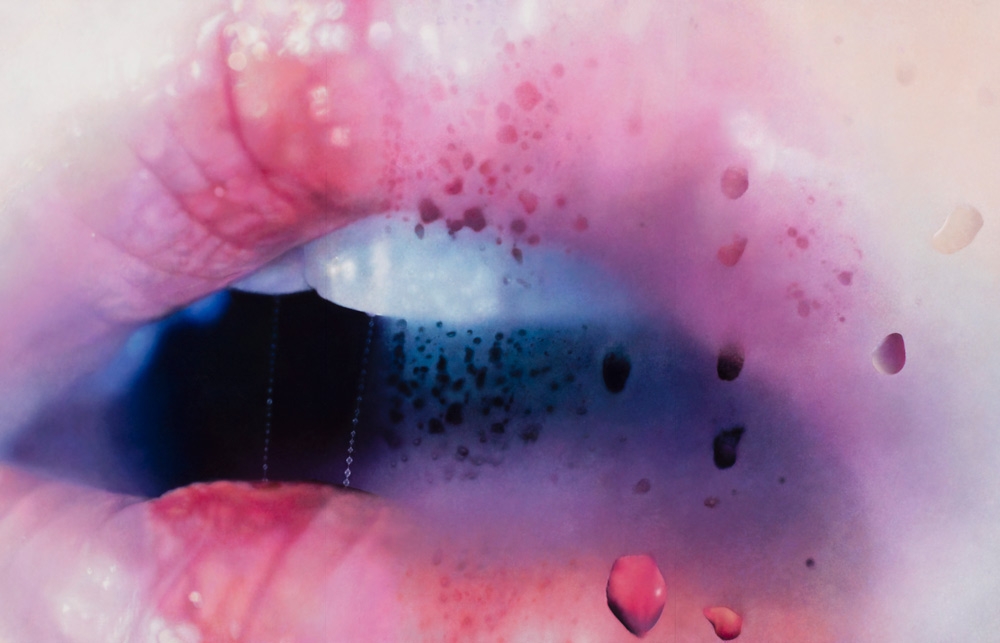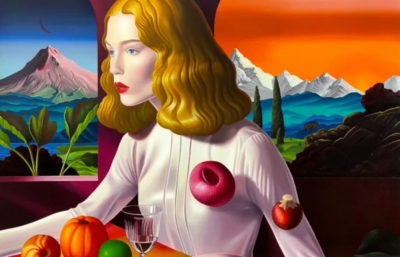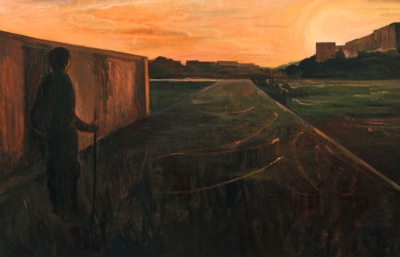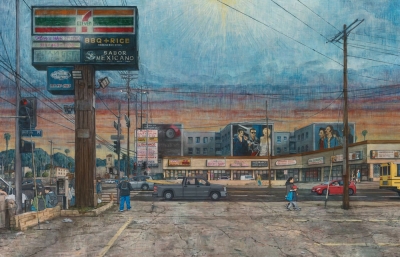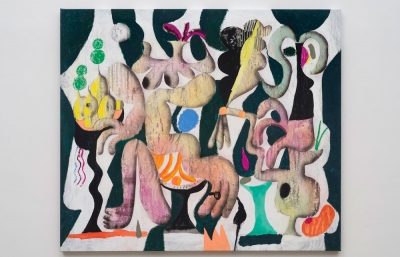Marilyn Minter
The Constant Rebel
Interview and story by Carlo McCormick
Isolation, that most disquieting quiet, and perhaps the cruelest of all tortures devised by our penal systems is very unlike the contemplative silence and purposeful focus of solitude. As we all find ourselves navigating an ongoing pandemic lockdown as a path from the former to the latter, we come to negotiate communication as a surrogate of community, a way of talking it out so we are, at least for a moment, less terrifyingly alone. Deprivation creates its own unruly and unpredictable desires. I remember once, during a period of incarceration, wishing mightily for a Big Mac, even though I had not been to a fast food franchise in decades before or since. By such circumstances of unpredictability I cannot say for sure why it felt important—even necessary—for me to talk to Marilyn Minter, but I know when Juxtapoz approached me about writing a feature, it was she who first came to mind. I really wanted to see what she had to say at this moment in time, to see how she was doing, and what had changed, as much as to know what was fundamentally unchangeable in her art, life and engagement with the world.
I’ve known Marilyn for some 40 years now, not in a way where we hang out all that much as before, but in that modern world fashion, where we are unmistakably old friends whenever we meet up. Over these many years, I’ve seen her emerge from downtown obscurity to international prominence, hone her vision from an eccentric formalism to an erotic fierceness, trespass the elegance of high fashion, and then traipse with these same muddy footprints through the corridors of fine art. And through this, somewhere along the way, we’ve witnessed her change from a bad girl prone to make bad decisions to an elder stateswoman whose courage, conviction and wisdom constitutes an enduring inspiration.

A longstanding professor at the School of Visual Arts, where she has, at times, terrified but always motivated generations of students, a provocateur who has continuously pressed the art world on its biases and limitations, and an activist who led protest rallies outside of the home of her collectors Ivanka Trump and Jared Kushner, and coined one of the greatest phrases ever for Planned Parenthood, “Don’t Fuck With Us Don’t Fuck Without Us,” Marilyn Minter has not achieved fame and significance by chance but by work and social ethics as unrelenting as they are uncompromising. Editorial decisions in a busy world are typically directed and timed to exhibitions and events, but at this time when the world has slowed down, we have this rare chance and honor to talk about what’s important. Crisis is an opportunity, and for all the myriad ways our lives have turned to hell, I am indeed grateful for this odd chance to reconnect with Marilyn.
Carlo McCormick: This pandemic and the ensuing lockdown is like a dream sequence for me, sitting in some station or airport looking at the arrival and departure board and watching all our plans roll over to be delayed and cancelled. How’s it feel to you?
Marilyn Minter: This is a good moment for all of us as individuals and as a society to think about the unbalance of power. For me, it’s been a long time coming. Something like a global pandemic changes the course of history. There is a reckoning happening right now, hopefully positive. On a personal note, I am happy to have the time to isolate and think. I listen to a lot of podcasts and let my curiosity guide me. I like to read at night and try not to wake up my husband, Bill. Right now I’m reading My Dark Vanessa by Kate Elizabeth Russell.It’s sort of a me-too book with a kick in the gut.

By my vague recollection, you really found your power as an artist when you began to examine beauty as an aesthetic and social construct. This was quite a turn for you, because, when we first met, you were doing these super photo-realist paintings of the most banal things imaginable, like coffee stains on a linoleum floor. I asked Chuck Close about Photorealism one time and he dismissed it as chrome pussy art, so you were already the exact opposite of that, and then, of course, you did a bunch of fashion work as a bridge into considerations of glamour. But it seems a thorny problem still, this issue of where sexuality fits within feminism. I wonder how much you have looked to artists like Carolee Schneemann, Ana Mendieta, Hannah Wilke or Betty Tomkins.
It was difficult to be a pro-sex feminist in the age of Andrea Dworkin. I have always been a pro-sex feminist. There is no such thing as politically correct fantasies; they take us to places that are neither comfortable nor correct. That’s where I wanted to go with my art. It’s funny you mention Betty Tomkins. We’ve known one another for maybe 50 years now. My ex-husband used to play pool with Betty's husband, Billy. Billy was the protégé of my landlord, who was his art teacher, and he was a real creep. He hit on everybody, even though we all loved his girlfriend. He was awful, so the fact that my landlord and her husband seemed to be friends put a distance between us, even though we were all hanging out at the same bars. Then, maybe 20 years ago, somebody asked me to comment about Betty’s work, and I realized I didn’t really know her work. When I finally saw it, I was blown away! She was so hardcore long before I was; I just didn’t know about it at the time. I also think of the work of Judy Bernstein, who was totally marginalized.
I remember seeing this show Mike Kelley did at Metro Pictures in 1989. He basically recreated an adolescent girl’s bedroom with those stuffed animals and candle tables, all so quotidian and dismissible. I thought to myself, a woman could never get away with this. We couldn’t use all that mall culture and female yearning in our work. Why don’t women own that agency? Why can’t we make our own images? And then, I thought, what else do female artists never touch? And it was hardcore pornography. I wondered how the meaning of hardcore pornography would change if, as a woman, I used it in my work. I got the answer. Feminists of my generation told me I was a traitor to my gender, and academics thought I had lost my mind. I remember getting excoriating reviews in the New York Times and Village Voice between 1992—1996. The only support I got was from the gay community, who were like, “Right on, Sister!”


I loved that Laurie Simmons movie, My Art, which you’re in, and when I told her how great that line was—“The art world loves young bad boys and old ladies”—she said that is something she heard you say.
I say it often, and it’s so true. At my age, you can get away with anything. The question is why is it so threatening for a young girl to have sexual agency? If you’re lucky like Betty and me, you get to live long enough to enjoy the zeitgeist. The marginalized are always hungry.
As outspoken and radical as you have been in your politics, your interrogation of beauty is perhaps even more subversive.
It has been effective. When you first met me, while I was making those paintings that looked like black-and-white photos, I thought I was a genius, but everyone thought the art was just so boring and terrible. Most things I do, people only start to like about 20 years later. Now everybody loves those paintings. There’s even interest in the collaborative paintings I made with Christoph Kohlhofer. No one buys the bush paintings I’ve made, and maybe they’re not easy to live with, but we’ll see in ten years.

I saw a few of the Kohlhofer/Minter paintings last year in a show at a museum in Korea. It had been ages since I first saw them, and they were utterly amazing still. How about the photos you took of your mother?
I took those photos of my mother in 1969 when I was in grad school. People thought they were shocking, and I felt waves of shame after I showed them to my classmates. My mom was a drug addict living down in Florida, and just such a mess. Linda Yablonski showed my mother’s photographs for the first time in 1995 at the Drawing Center, and that’s actually what got me back in the art world after I was kicked out for the hardcore porn work.
Back to your original question about beauty. Working with the beauty industry, which includes fashion, models, accessories and make-up, gave me so many ideas for paintings. I did projects for Mac Cosmetics, Tom Ford, and Jimmy Choo, and made whole bodies of work from the outtakes of those commercial shoots. The whole beauty industry is all-encompassing. Glamour, fashion, and porn, for that matter, are giant engines of the culture. They are also considered contemptible, dismissible, and superficial, but they also give people so much pleasure. I like to pick that binary apart in my work.
My interest in beauty and fashion has more to do with emphasizing what’s there but hasn’t been photographed before or gets airbrushed out, like the lines on your legs when you pull your socks down, the dirt, sweat, armpit hair, pimples and freckles. Everything I make is gorgeous, to suck you in and seduce you, and that includes a lot of things that don’t fit the established beauty ideals. That’s what I’m working on now with my 21st Century Bathers. They are not allegorical bathers like a Degas. They are real women: big women, brown women, tattooed women, women with armpit hair. The paintings are more pointillist than photorealist, as they are seen behind steamy glass. I was supposed to be out in LA now, shooting Beyoncé and Lizzo for this project, but the trip, the show, everything is just postponed.

"My interest in beauty and fashion has more to do with emphasizing what’s there but hasn’t been photographed before or gets airbrushed out..."
That’s the existential dilemma now—how to go forward in the great interruption, how to still do things when there is nothing to do, and to make them meaningful rather than just staying busy. Maybe, for me, it was just this chance to talk with you, for which I am really grateful. But, for you, how else are you registering this change, and how has your ongoing activism kept your focus?
I still go into the city three times a week to print and work on paintings. The art market is barely running and I heard from my dealer that collectors are asking for a 30% covid discount.
I’ll always be an activist, though I am more of a trickster propagandist than a moralist. I grew up fighting for civil rights down in the South and I just can’t give it up. It’s part of my DNA at this point. I do work for Planned Parenthood, Downtown for Democracy, Swing Left, among others. The Trump cult we are fighting is strong. It’s the last gasp of a toxic patriarchy fighting for a belief system that never worked. I’m working on advocacy for mail-in voting and trying to flip Michigan and the Electoral College that could still fuck us. I’m hopeful that soon we won’t be ruled by white guys who dictate reproductive rights. Change is coming.
Marilynminter.net

